Billing examples/scenarios
Managers Partners Billers
This topic provides examples of how various billing scenarios can be set up and used. The information contained in each example relates to the process involved.
Manual Bills
Manual Bills are those bills that have a Job Billing Type of Manual. They can be created from either the Client Dashboard, the Client New Draft Bill page or from the Client, Service or Job Ownership portfolios within the Billing portfolio.
This example will run through how to set up the job and then how to draft and confirm the bill. It is assumed that the process of creating a job on a client is known. It uses an Allocation type of Automatic Pro Rata when Closed.
Setting the Job Details
-
Create a new job for the client and open the Job Details.
Although a manual job does not require a Job Billing Value, it is advisable to enter one.
-
Open the Management panel and enter a Job Billing Value - this is the value that was agreed with the client. For manual bills it is not used during the billing process.
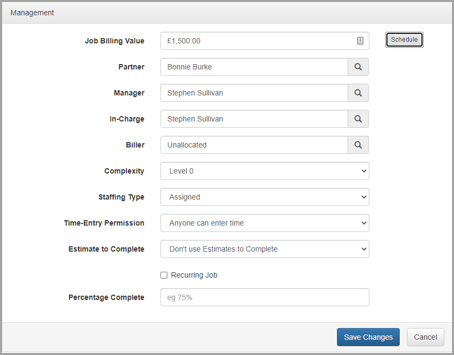
-
Save any changes that have been made.
-
Select the Billing panel from the Job Details page.
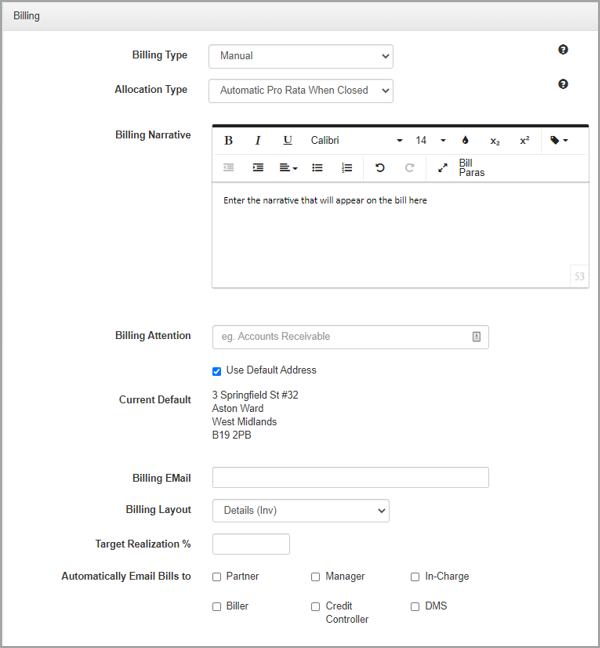
-
Set the Billing Type to be Manual, then select the required Allocation Type.
-
If the narrative on the draft bill is going to be built By Job, enter a Billing Narrative - this is the narrative that will then appear on the draft bill.
-
Enter any further details, that may be required. The Billing Email, Billing Layout and Automatic Email Bills to will only apply if doing a single Job bill.
-
Save any changes that have been made.
Drafting the Bill
The bill can be drafted from several places:
-
the Client Dashboard, using the bills dashlet
-
the New Draft Bill page accessed from the Client Menu
-
the Client, Service or Job Ownership portfolios within the Billing portfolio.
When selecting to draft the bill, the New Draft Bill Details page is displayed:
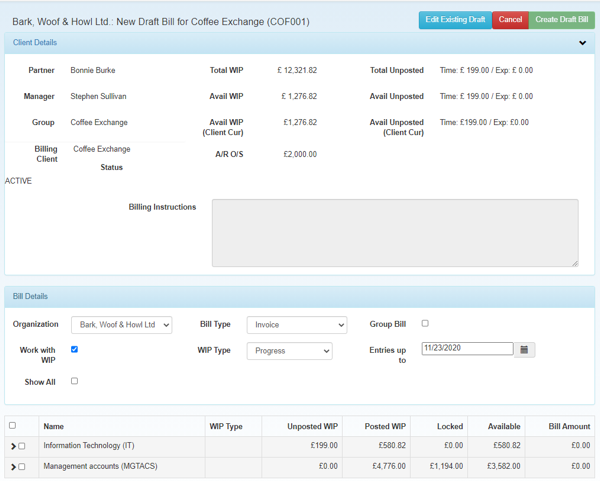
The Client Details section contains information relating to the client details and the available WIP, together with any Bill Instructions that may have been entered onto the client's WIP/Billing page.
The Bill Details section contains various options that will affect the bill creation. See Create draft bills.
At the bottom of the page, the list of Manual Jobs with available WIP is displayed.
Select the Job(s) to be included in the bill. Once at least one job has been selected, the Create Draft Bill button will be enabled. When clicked, this will open the Draft Bill Wizard which consists of 4 tabs:
-
Header
-
Analysis
-
Narrative
-
Actions
Header tab
This tab will displays the client details, options to set the bill date, the bill layout to be used, the delivery format, together with the bill Partner and Manager:
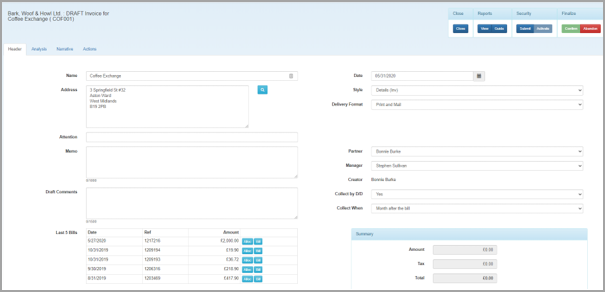
Analysis tab
Enter the amount to be billed in the Bill field. Adjust the Write Off amount if required. Any Carry Forward isautomatically calculated. Repeat for all jobs that are included in the draft bill:

Narrative tab
This tab is used to enter the bill wording..
Actions tab
This tab is used to add attachments to the bill. See .
Submitting and Confirming the Bill
A bill cannot be confirmed until it has been Submitted. Submitting a bill runs any policy checks that are in place and indicates if there are any problems with the bill. See Submit and confirm a bill.
Pre-defined Bills - Based on Job
Pre-defined bills are bills where the billing amount, narrative and other details have already been set up. These details are used when drafting the bill from the Job Billing portfolio within the Billing portfolio.
This example showsr how to set up the job then how to draft and confirm the bill. It is assumed that the jprocess of creating a job for a client is known. I
Set the Job Details
-
Create a new job for the client and open the Job Details.
-
On the Management panel, ensure that a Job Billing Value has been entered. This will be used as the amount to be billed when the bill is drafted, and cannot be changed.

-
Save any changes that have been made.
-
Select the Billing panel from the Job details:
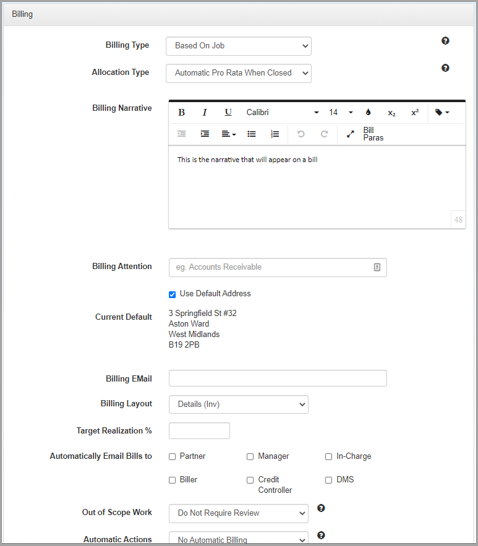
-
Select Based on Job from the Billing Type list.
-
Select the required Allocation Type.
-
Enter the Billing Narrative to be the wording that will appear when the bill is drafted.
-
Enter any further details, that may be required.
-
Save any changes that have been made.
Drafting the Bill
Once the job has been marked as Complete it will be displayed in the Job Billing portfolio of the Billing Portfolio.
Open the Billing portfolio and select Job Billing from the listof available portfolios. The completed job will be displayed.

Select Draft from the Action column to draft the bill. The bill ismoved into the Drafts as Owner/ Creator portfolios from where it can be edited or confirmed as required.
Confirming the Bill
From the Billing portfolio, select Drafts as Owner or Drafts as Creator from the portfolio list
The drafted bill isisdisplayed. Select Confirm from the Actions column, to confirm the bill. The Confirm bill dialog isdisplayed, with options to change the or add attachments.
Click OK to confirm the bill.

Pre-defined Bills - Based on Schedule
Scheduled bills are pre-defined bills based on a set schedule. Scheduled bills appear in the Job Scheduled Billing portfolio within the Billing portfolio when they are triggered.
This example describes how to set up the job, the billing schedule and how to draft and confirm the bill. It is assumed that the process of creating a job for a client is known. It uses an Allocation type of Automatic Pro Rata when Closed.
Sett the Job Details
-
Create a new job fortheclient and open the Job Details.
-
On the Management panel, ensure that a Job Billing Value has been entered. This will be used as the amount to be billed when the bill is drafted and cannot be changed.
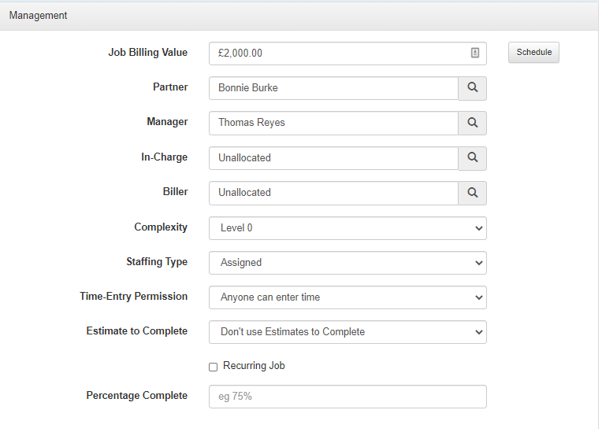
-
Save any changes that have been made.
-
Select the billing panel from the Job details:
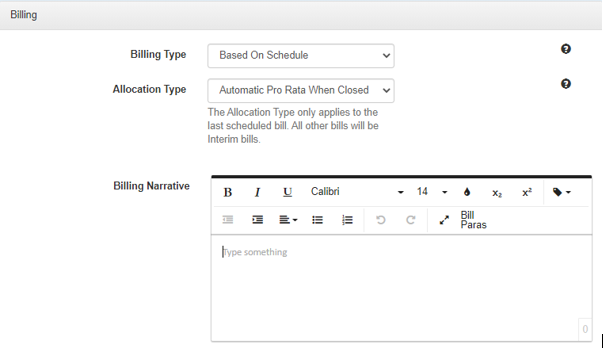
-
Select Based on Schedule from the Billing Type list.
-
Select the required Allocation Type.
-
Enter a Billing Narrative if required. This will be set on the line items of the billing schedule.
-
Enter any further details, that may be required.
-
Save any changes that have been made.
-
Click Billing Schedule Billing Schedule to display the Job Billing Schedule page:

-
Select the Schedule Type to be used. An explanation of the schedule types can be displayed by hovering over the ?.
-
Enter the total number of bills that will make up the schedule of bills.
-
The Job Billing value is displayed but cannot be changed. If a change to this value is required, it must be done on the Job Details pages.
-
Click Apply if any changes have been made to the top section.
-
Enter the Trigger value (this will depend on the schedule type that has been selected).
-
Enter the bill amount. Select the date to be used, the narrative type and the layout.
-
If Bill Paragraph or Previous bill is selected from the Narrative Type list, select the required paragraph or bill paragraph to be used. If Manual is selected, enter the required narrative .
-
Select Job Completion or Fixed date from the Final Bill Trigger list.
-
The Final Bill Amount is derived from the Job Billing Value minusany other scheduled bills.
-
Enter the narrative for the final bill then click Save. Close the billing schedule to return to the Job details pages.
Draft the Bills
Once the schedule triggers have been met, the job will appear in the Job Scheduled Billing portfolio within the Billing portfolio.
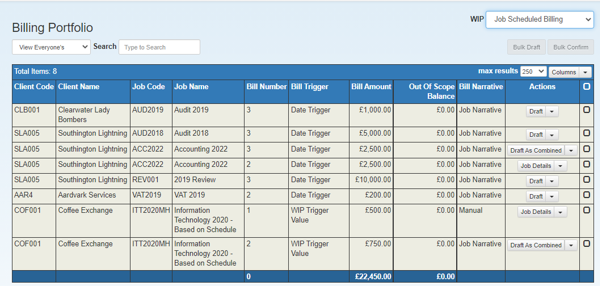
SelectDraft from theActions column. Once drafted, it is displayed in the Drafts as Owner/Drafts as Creator portfolios where it can be edited and confirmed as required.
If multiple scheduled bills are triggered at a similar time, it is possible to combine the bills from the Job Scheduled billing portfolio. Select either Draft as Combined or Confirm as Combined from the Actions columnof the later scheduled bill. (This can be determined from the bill number.)
Final Bills
Final bills should be used when the job has been completed and the final bill is to be raised. Raising a final bill will result in the job being marked as closed and any WIP that is not being billed will be written off.
By default, any job that is billed as Based on Job, Based on Task or Based on Schedule will have the last bill raised as a Final Bill.
Setting a job to be billed as part of a Manual Final Bill can be done in two ways:
- When drafting a manual bill, setting the Billing Type to Final on the New Draft Bill page.
- Within the Draft Bill wizard, set the Billing Type on the Analysis screen to be Final.